ISSUE
AUTHOR
VOLUME
PAGE
SUBJECT
It’s been 10 years since SAM first took up the best/worst quest. In the old days, this was mostly a matter of reviewing ads in magazines. But media have changed tremendously, and as a smart guy once said, “the medium is the message.” Resorts now have a lot of stories to tell, and many ways to tell them. As do their guests.
The explosion in media makes our task of assessing the year’s output a team effort. We have compiled a team of well-versed and thick-skinned critics, who sought out not just good advertising, promotions, and marketing, but the truly stand-out programs.
“As a marketer, I’m always looking for the next great idea,” reviewer Samantha Rufo says. “It’s really my white whale. I think that’s why, when I see a really good idea, I wonder why I hadn’t thought of it first. So, that was my mission this past winter—find marketing campaigns that made me stop and think, ‘why didn’t I think of that?’” That’s how a lot of the best marketing struck us.
The main theme this year is engagement: in print, on the slopes, on the web, and in guests’ neighborhoods. Take a look.
GENERAL MARKETING
BEST EXECUTION OF SPEED DATING: CRESTED BUTTE, COLO., AND BEAR CREEK, PA.
My favorite promotion, by far, was chairlift speed dating. It’s amazing that two separate resorts in different parts of the country had the same idea.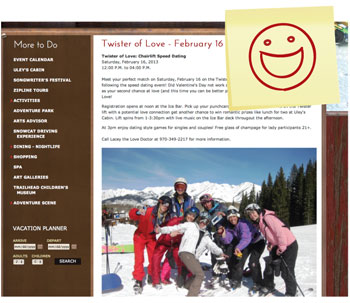 Crested Butte’s Twister of Love event took advantage of the Saturday after Valentine’s Day. It involved a punch card, romantic prizes, and live music after “potential love connections” rode the Twister lift for what the resort called “a second chance at love if Valentine’s Day didn’t work out.” Sometimes it’s about the details, and I especially like that people could contact “Lacey the Love Doctor” for more information.
Crested Butte’s Twister of Love event took advantage of the Saturday after Valentine’s Day. It involved a punch card, romantic prizes, and live music after “potential love connections” rode the Twister lift for what the resort called “a second chance at love if Valentine’s Day didn’t work out.” Sometimes it’s about the details, and I especially like that people could contact “Lacey the Love Doctor” for more information.
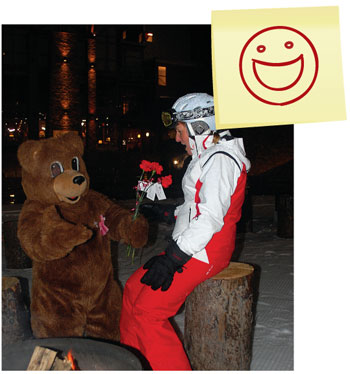 Bear Creek went a bit further. Its Lift of Love event Valentine’s Day allowed participants to purchase $14 tickets (a nod to the date) and hang out by Cupid’s Fire in the Lift of Love VIP area while snacking on free s’mores and listening to live music. It also offered romantic prizes from two sponsors, a florist and a jeweler. The event even had its own logo.
Bear Creek went a bit further. Its Lift of Love event Valentine’s Day allowed participants to purchase $14 tickets (a nod to the date) and hang out by Cupid’s Fire in the Lift of Love VIP area while snacking on free s’mores and listening to live music. It also offered romantic prizes from two sponsors, a florist and a jeweler. The event even had its own logo.
I really love the shift from focusing on couples to singles; it sidesteps competing with other businesses on a traditionally couples-only day. Bear Creek pushed this advantage well, cooing, “you have a full seven minutes to meet the person of your dreams or find a ski buddy.” That’s a strong statement. And it happens: at press time, at least one couple that met on the lift was still dating.
These promotions cost almost nothing to do. The resorts simply used the tools they already had—website, email newsletters, blog, social media, and PR— to generate excitement and offer a unique experience to guests.—S.R.
BEST BRING-A-FRIEND PROGRAMS: KILLINGTON/PICO, VT., AND SUGARLOAF, ME.
Many “Bring A Friend” learn-to programs are too complicated or restricted. This is a lost marketing opportunity; the idea is to get existing skiers and snowboarders to introduce newbies.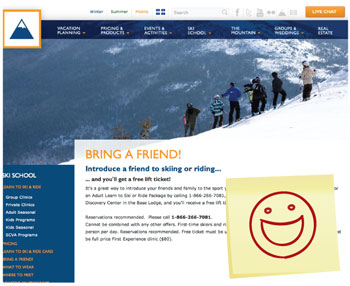 Why not let every existing skier or rider bring their friends whenever they want? Simplicity is the key. Killington, Pico, and Sugarloaf reward any veteran skier with a free lift ticket if they brought a beginner. That’s it. So simple.
Why not let every existing skier or rider bring their friends whenever they want? Simplicity is the key. Killington, Pico, and Sugarloaf reward any veteran skier with a free lift ticket if they brought a beginner. That’s it. So simple.
Sugarloaf went a step further: Gold Season passholders could buy up to 4 Bring a Friend tickets at $50. And a third of their passholders did just that. —S.R.
WORST EXAMPLE OF CRYING WOLF: VAIL RESORTS
 We all know the story of the boy who cried wolf. Vail Resorts might have become that boy last year with its season pass deadlines—or lack thereof. Vail’s "lowest guaranteed price" deadline came and went not once, not twice, but four times—and then was extended one more time. In each case, a different feature became the key selling point until the next “deadline” passed. When the price finally did rise, the increase was $20—just 3 percent of the total price. This lack of consequence weakens the effectiveness of future deadlines.—G.B.
We all know the story of the boy who cried wolf. Vail Resorts might have become that boy last year with its season pass deadlines—or lack thereof. Vail’s "lowest guaranteed price" deadline came and went not once, not twice, but four times—and then was extended one more time. In each case, a different feature became the key selling point until the next “deadline” passed. When the price finally did rise, the increase was $20—just 3 percent of the total price. This lack of consequence weakens the effectiveness of future deadlines.—G.B.
BEST SEASON’S PASS PROMOTION: KILLINGTON, VT.
Resorts take many approaches to differentiate their passes. Pricing, resort partnerships, perks and bonuses are all employed to get folks to buy.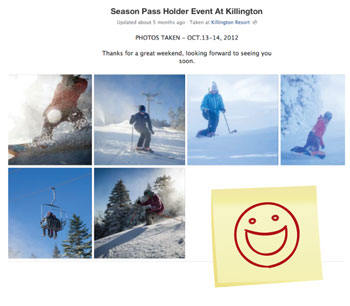 Ultimately, however, skiers and riders want to be on the slopes, and few things reward buyers for their purchase like an early opening day exclusively for passholders, as Killington hosted in October 2012. A small window of cold temps let The Beast show it was serious about its commitment to snowmaking. Passholders at other mountains couldn’t help but think twice about Killington passholders’ status, and destination guests got the clear message that Killington was serious about blowing snow. —G.B.
Ultimately, however, skiers and riders want to be on the slopes, and few things reward buyers for their purchase like an early opening day exclusively for passholders, as Killington hosted in October 2012. A small window of cold temps let The Beast show it was serious about its commitment to snowmaking. Passholders at other mountains couldn’t help but think twice about Killington passholders’ status, and destination guests got the clear message that Killington was serious about blowing snow. —G.B.
BEST WEBSITE REDESIGN: SNOWBIRD, UTAH
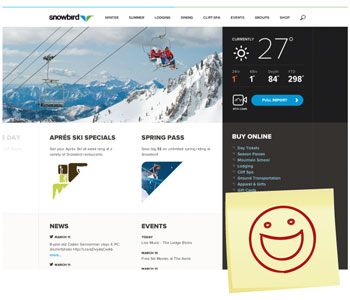 Most resort website designs are incremental, some are not. Snowbird’s 2012-13 revamp was clearly the latter. Created by Rally Interactive, the resort’s new site launched to rave reviews from marketers and users alike. The site is fully responsive to display beautifully on all device sizes, and implements clear practices that make it extremely easy (and honestly fun) to use. —G.B.
Most resort website designs are incremental, some are not. Snowbird’s 2012-13 revamp was clearly the latter. Created by Rally Interactive, the resort’s new site launched to rave reviews from marketers and users alike. The site is fully responsive to display beautifully on all device sizes, and implements clear practices that make it extremely easy (and honestly fun) to use. —G.B.
BEST BILLBOARDS: POWDER MOUNTAIN, UTAH
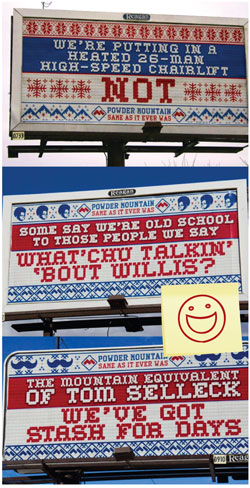 Powder Mountain sits an hour from Salt Lake City, further than Snowbird, Alta, Deer Valley, Park City, and Canyons, to name a few. So how to reach the locals and compete with such resorts? Powder chose humor though a series of clever, witty billboards. Designed to look as if there were knit from a giant ball of yarn, sayings like “Yeah, we’ve got snowmaking machines...we call ‘em clouds” and “We totally have an oxygen bar...it’s called OUTSIDE” grabbed attention, a few headlines, and helped build the brand in a competitive state. —G.B.
Powder Mountain sits an hour from Salt Lake City, further than Snowbird, Alta, Deer Valley, Park City, and Canyons, to name a few. So how to reach the locals and compete with such resorts? Powder chose humor though a series of clever, witty billboards. Designed to look as if there were knit from a giant ball of yarn, sayings like “Yeah, we’ve got snowmaking machines...we call ‘em clouds” and “We totally have an oxygen bar...it’s called OUTSIDE” grabbed attention, a few headlines, and helped build the brand in a competitive state. —G.B.
BEST APPEAL TO OUR BETTER NATURE: BRISTOL MOUNTAIN, N.Y.
Some ski resorts have dogs. Others have mammoths. And Bristol has snow angels. Bristol is promoting a sense of community by encouraging random acts of kindness at the area through its Snow Angel program.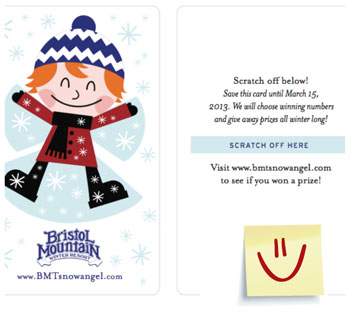 The area is promoting RAK on its Snow Angel website, via signage at the resort and on social media, and with a personal Snow Angel Card. Social networks contribute by showcasing random acts of kindness. It doesn’t hurt that media outlets picked up the story, too. The campaign is supported with various prizes as well. This is a brilliant way to create a community spirit on the mountain.—M.R.
The area is promoting RAK on its Snow Angel website, via signage at the resort and on social media, and with a personal Snow Angel Card. Social networks contribute by showcasing random acts of kindness. It doesn’t hurt that media outlets picked up the story, too. The campaign is supported with various prizes as well. This is a brilliant way to create a community spirit on the mountain.—M.R.
SOCIAL MEDIA
LONGEST-RUNNING FACEBOOK PROMOTION: BLUE MOUNTAIN, PA.
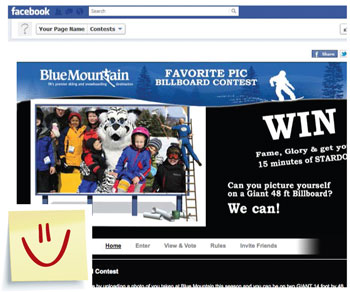 Blue Mountain built some huge engagement around a 12-week contest. Before this winter, I believed that a Facebook contest should last about two weeks, never more than three. But Blue’s contest had a twist: the contest reset each week. Starting in December, folks could upload their image and try to get the most votes to win. Each week, the picture with the most public votes won lift tickets—and graced a 14 ft. x 48 ft. digital highway billboard for a week. That’s impressive.
Blue Mountain built some huge engagement around a 12-week contest. Before this winter, I believed that a Facebook contest should last about two weeks, never more than three. But Blue’s contest had a twist: the contest reset each week. Starting in December, folks could upload their image and try to get the most votes to win. Each week, the picture with the most public votes won lift tickets—and graced a 14 ft. x 48 ft. digital highway billboard for a week. That’s impressive.
Blue figures this contest helped to reach more than six million people on Facebook alone (plus all those billboard views) and added more than 16,000 “likes” to Blue’s Facebook page. Plus, there were no paid ads for this campaign, it was almost completely viral. —S.R.
BEST ALL-AROUND SOCIAL MEDIA EXECUTION: SUNSHINE VILLAGE, ALBERTA
Two years removed from a major social media fail, Sunshine Village really gets it. With 51,000 Facebook fans, 15,000 Twitter fans, 302,143 YouTube views, and 1,500 Google+ followers, Sunshine is doing a lot right. Any social media channel they are on, they optimize and use it to the fullest. And in all instances, Sunshine shows off its snow with rulers and familiar or funny objects.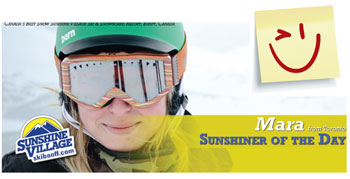 On Facebook, Sunshine posts often and uses lots of brochure-quality images, spanning across the entire newsfeed on their page. It uses eye-catching graphics and treats the page with the same care and attention that they would a glossy brochure. When not posting new images, the area posts videos—mini movies that seem carefully thought out, yet spontaneous at the same time. And the cover photo features a “Sunshiners of the Day.” Plus, the area takes advantage of every Facebook app space to promote or encourage a purchase. —S.R.
On Facebook, Sunshine posts often and uses lots of brochure-quality images, spanning across the entire newsfeed on their page. It uses eye-catching graphics and treats the page with the same care and attention that they would a glossy brochure. When not posting new images, the area posts videos—mini movies that seem carefully thought out, yet spontaneous at the same time. And the cover photo features a “Sunshiners of the Day.” Plus, the area takes advantage of every Facebook app space to promote or encourage a purchase. —S.R.
BEST MOBILE MESSAGING: SQUAW VALLEY, CALIF.
One of the best resort marketing tactics of last season was also one of the simplest. Squaw Valley used a new, European app platform from Lumiplan for its resort mobile presence. Aside from run tracking and interactive features, this app had a small bonus: push notifications to all app users.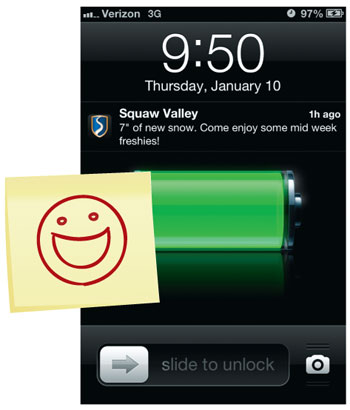 These short, simple text messages show up as alerts on smartphones and are virtually free to send to the estimated 15,000-20,000 Squaw app users. Even more, alerts could be targeted based on location, using initial coordinates from the smartphone's GPS system. —G.B.
These short, simple text messages show up as alerts on smartphones and are virtually free to send to the estimated 15,000-20,000 Squaw app users. Even more, alerts could be targeted based on location, using initial coordinates from the smartphone's GPS system. —G.B.
MOST OPPORTUNISTIC USE OF A DOG: NORTHSTAR, CALIF.
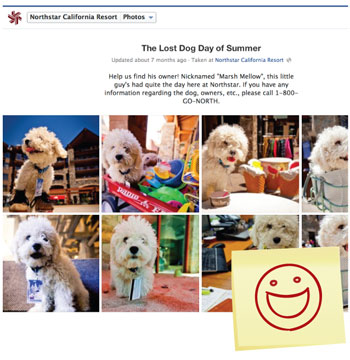 You see a stray dog in your village, and what do you do? Probably call animal control. Northstar, however, saw opportunity. Marsh Mellow, as he’s now known (a name based on the free s’mores served to Northstar guests), was treated to a day full of ice cream, roller skating, and a tour of the marketing offices—all documented via social media. When those same social channels failed to reach the dog’s owner, the marketing team adopted the pup and gave their brand an authentic face that no media buy could achieve. Months later, guests were still seeking out Marsh Mellow during their stays. —G.B.
You see a stray dog in your village, and what do you do? Probably call animal control. Northstar, however, saw opportunity. Marsh Mellow, as he’s now known (a name based on the free s’mores served to Northstar guests), was treated to a day full of ice cream, roller skating, and a tour of the marketing offices—all documented via social media. When those same social channels failed to reach the dog’s owner, the marketing team adopted the pup and gave their brand an authentic face that no media buy could achieve. Months later, guests were still seeking out Marsh Mellow during their stays. —G.B.
WORST SILENCE AFTER SANDY: SNOWSHOE MOUNTAIN, W.V.
 Hurricane Sandy meant devastating rain for some, and deep snow for a few. While the PR team at Snowshoe snagged coverage of its snowfall on traditional media outlets, its social media voice was eerily silent. Hundreds of fans and followers begged for updates on a variety of topics, from skiing to power outages, safety, and damage. Even though live video was broadcast for TV coverage on day one, it wasn’t until day three that a quick update appeared on Facebook. The area’s nearly 7,000 Twitter followers didn’t hear any news until day five. All this left Snowshoe’s social media fans uninformed and frustrated. —G.B.
Hurricane Sandy meant devastating rain for some, and deep snow for a few. While the PR team at Snowshoe snagged coverage of its snowfall on traditional media outlets, its social media voice was eerily silent. Hundreds of fans and followers begged for updates on a variety of topics, from skiing to power outages, safety, and damage. Even though live video was broadcast for TV coverage on day one, it wasn’t until day three that a quick update appeared on Facebook. The area’s nearly 7,000 Twitter followers didn’t hear any news until day five. All this left Snowshoe’s social media fans uninformed and frustrated. —G.B.
BEST USE OF A ROBOT: SUN VALLEY, IDA.
Summer can be a dead time for many ski resorts and their marketing messages. So how do you get your brand in skiers’ minds? Sun Valley partnered with interactive agency 11 Inc. to build a stone-skipping robot.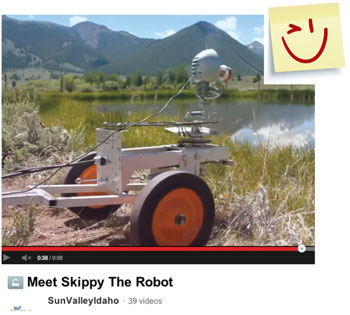 From the comfort of a computer, visitors could manipulate the controls and skip stones across a serene pond near Ketchum, Idaho. The media quickly found and spread the story, which led to thousands of stone skippers, all of whom provided contact information to a robot cleverly disguised as a lead generation tool. —G.B.
From the comfort of a computer, visitors could manipulate the controls and skip stones across a serene pond near Ketchum, Idaho. The media quickly found and spread the story, which led to thousands of stone skippers, all of whom provided contact information to a robot cleverly disguised as a lead generation tool. —G.B.
BEST SOCIAL MEDIA PARTNERSHIP: SUGAR BOWL, CALIF.*
Facebook contests, giveaways, and sweepstakes are everywhere. Sugar Bowl Resort broke through the clutter with a clever combination of traditional and online reach to a key audience: ski shops and their fans.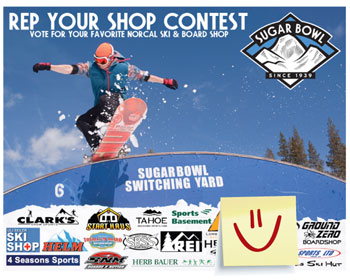 The “Rep Your Shop” Facebook contest ran for three weeks in February. Sugar Bowl fans voted for their favorite Northern California ski & board shops, and one voter was chosen to receive 5 free tickets and 5 meal vouchers. The winning shop got bragging rights plus 20 tickets to reward its employees.
The “Rep Your Shop” Facebook contest ran for three weeks in February. Sugar Bowl fans voted for their favorite Northern California ski & board shops, and one voter was chosen to receive 5 free tickets and 5 meal vouchers. The winning shop got bragging rights plus 20 tickets to reward its employees.
The resort partnered with its most loyal vendors and reached out to their customers. The shops got behind the concept and promoted it in the stores as well as on Facebook. All these sources gave Sugar Bowl an extra boost during a relatively dry February. The resort itself promoted the contest via Facebook, Twitter, e-blasts, newsletters, text messages and radio. Its fan base grew more than 13 percent.—M.R.
* Full disclosure: Sugar Bowl is a client of the reviewer.
WEAKEST SOCIAL MEDIA PLAYERS: STATE ASSOCIATIONS
 While about 70 percent of all ski areas have a social media presence, that number is closer to 98 percent for resorts with more than 250,000 visits. These areas are likely to be the biggest supporters of regional ski area associations, yet many associations fall well below average when ranked by fans and followers (and even lower on engagement) alongside their member resorts. Associations aren’t doing themselves any favors with sub-par stats on this highly visible channel. —G.B.
While about 70 percent of all ski areas have a social media presence, that number is closer to 98 percent for resorts with more than 250,000 visits. These areas are likely to be the biggest supporters of regional ski area associations, yet many associations fall well below average when ranked by fans and followers (and even lower on engagement) alongside their member resorts. Associations aren’t doing themselves any favors with sub-par stats on this highly visible channel. —G.B.
BEST MEASURE OF SOCIAL MEDIA ROI: SQUAW VALLEY/ALPINE MEADOWS, CALIF.*
 While many companies are scratching their heads about social media ROI, Squaw Valley/Alpine Meadows took its measure by making loyal fans an exclusive Facebook offer: a $25 gift card with the purchase of a season pass made during a three-day period. More than 2,600 gift certificates were claimed. In addition to gaining 2,535 new fans, Squaw Valley/Alpine Meadows were able to see a 337 percent return on their marketing dollars, as most of the purchases came from new season passholders. That’s one way to quantify your social media ROI. —M.R.
While many companies are scratching their heads about social media ROI, Squaw Valley/Alpine Meadows took its measure by making loyal fans an exclusive Facebook offer: a $25 gift card with the purchase of a season pass made during a three-day period. More than 2,600 gift certificates were claimed. In addition to gaining 2,535 new fans, Squaw Valley/Alpine Meadows were able to see a 337 percent return on their marketing dollars, as most of the purchases came from new season passholders. That’s one way to quantify your social media ROI. —M.R.* Full disclosure: Squaw Valley/Alpine Meadows are a client of the reviewer.
LEAST ACCOUNTABLE ROI: SOCIAL MEDIA
 Mention the words “social media ROI” to a resort marketer, and the response is somewhere between a blush and frustration. Yet, for all the talk of how difficult measuring social media ROI is, nearly all resorts fail to add Google Analytics tags to their social media links. These tags allow resorts to separate organic social media traffic from their own efforts, and to link various campaigns to actual actions or transactions on their site. It’s simple to do, too. But in an analysis of more than 60,000 ski resort tweets, fewer than 0.1 percent of links to a mountain’s website were using these tags. —G.B.
Mention the words “social media ROI” to a resort marketer, and the response is somewhere between a blush and frustration. Yet, for all the talk of how difficult measuring social media ROI is, nearly all resorts fail to add Google Analytics tags to their social media links. These tags allow resorts to separate organic social media traffic from their own efforts, and to link various campaigns to actual actions or transactions on their site. It’s simple to do, too. But in an analysis of more than 60,000 ski resort tweets, fewer than 0.1 percent of links to a mountain’s website were using these tags. —G.B.
VIDEO
BEST PEEK BEHIND THE SCENES: ASPEN/SNOWMASS, COLO.
 Aspen Skiing Company, Chase Jarvis and Factory Design Labs created the 2012-13 season Aspen/Snowmass campaign using a combination of traditional and online marketing. My two favorite elements from the campaign are the Behind the Scenes video, which showed the making of the campaign, and the partnership with Chase Jarvis, a videographer, blogger and photographer with a huge following. With 202,561 views by early March, this video is proof that people love to get that inside view. Among the other measurables of the collaboration with Jarvis: Chase’s blog drew 226,000 unique visitors the week of the campaign photo shoot, and Aspen/Snowmass increased Twitter followers by 17 percent. Followers shared with Chase Jarvis grew by 44 percent. Connecting with influencers who can reach new audiences will be the way of the future.
Aspen Skiing Company, Chase Jarvis and Factory Design Labs created the 2012-13 season Aspen/Snowmass campaign using a combination of traditional and online marketing. My two favorite elements from the campaign are the Behind the Scenes video, which showed the making of the campaign, and the partnership with Chase Jarvis, a videographer, blogger and photographer with a huge following. With 202,561 views by early March, this video is proof that people love to get that inside view. Among the other measurables of the collaboration with Jarvis: Chase’s blog drew 226,000 unique visitors the week of the campaign photo shoot, and Aspen/Snowmass increased Twitter followers by 17 percent. Followers shared with Chase Jarvis grew by 44 percent. Connecting with influencers who can reach new audiences will be the way of the future.
The “Before Aspen” ad campaign itself has been effective, too. It highlights some of Aspen/Snowmass’ key assets and trendsetting ways via print, billboard, web and social media.—M.R.
MOST TRUTH IN MARKETING: PARK CITY, UTAH
 All ski marketers tell lies snow stories. It’s true! Having lived in the ski resort marketing world for 10 years, I know that the job of a ski resort marketer is very dependent on Mother Nature. I loved this video from the smart folks at Park City Utah who took a playful approach to show the world what a day in the life of a ski resort marketer looks like when it snows and when it doesn’t. Brutally honest, transparent and funny, they showed the good with the bad. .—M.R.
All ski marketers tell lies snow stories. It’s true! Having lived in the ski resort marketing world for 10 years, I know that the job of a ski resort marketer is very dependent on Mother Nature. I loved this video from the smart folks at Park City Utah who took a playful approach to show the world what a day in the life of a ski resort marketer looks like when it snows and when it doesn’t. Brutally honest, transparent and funny, they showed the good with the bad. .—M.R.
GREATEST VIDEO INNOVATION: SIERRA AT TAHOE, CALIF.
 Sierra at Tahoe partnered with Zeal Optics and ION cameras to showcase real mountain conditions with the “Goggles Don’t Lie” campaign. Zeal’s goggle/cam-era technology allows guests to see the conditions through the eyes of the snow reporters. Each Friday, reporters posted footage to Sierra’s Facebook page. The goggle/cameras were also used to provide real-life tips and improvement pointers in ski and snowboard lessons. The immediacy of all this brings people closer to the mountain and provides them with real conditions and personal progress reports, without any filters or sugar coating.—M.R.
Sierra at Tahoe partnered with Zeal Optics and ION cameras to showcase real mountain conditions with the “Goggles Don’t Lie” campaign. Zeal’s goggle/cam-era technology allows guests to see the conditions through the eyes of the snow reporters. Each Friday, reporters posted footage to Sierra’s Facebook page. The goggle/cameras were also used to provide real-life tips and improvement pointers in ski and snowboard lessons. The immediacy of all this brings people closer to the mountain and provides them with real conditions and personal progress reports, without any filters or sugar coating.—M.R.
MOST IMMEDIATE TV ADS: WACHUSETT MOUNTAIN, MASS.
 A well-known TV brand in the Boston market, Wachusett increased its advertising frequency, reduced its spot length, and revamped its production schedule to make TV spots more timely. Wachusett committed to same-day turnaround, with a date stamp on each ad spot. The area then ran three :05-second spots a night. The spots included the area’s well-known jingle and displayed a brief message. In addition to these spots, the mountain produced weekly “instant commercials” to showcase snow quality and up-to-date conditions. We all live in the “now,” thanks to social media and technology, and Wachusett has found a clever way to bring that same freshness to traditional media channels, too.—M.R.
A well-known TV brand in the Boston market, Wachusett increased its advertising frequency, reduced its spot length, and revamped its production schedule to make TV spots more timely. Wachusett committed to same-day turnaround, with a date stamp on each ad spot. The area then ran three :05-second spots a night. The spots included the area’s well-known jingle and displayed a brief message. In addition to these spots, the mountain produced weekly “instant commercials” to showcase snow quality and up-to-date conditions. We all live in the “now,” thanks to social media and technology, and Wachusett has found a clever way to bring that same freshness to traditional media channels, too.—M.R.
WORST VIRAL VIDEO: HARLEM SHAKE
 Ski resorts jumped on what was supposed to be their “viral” video of the season. Some were more clever than others, but anyone after Copper was simply copying the idea. The videos got more than a tad annoying.—M.R.
Ski resorts jumped on what was supposed to be their “viral” video of the season. Some were more clever than others, but anyone after Copper was simply copying the idea. The videos got more than a tad annoying.—M.R.
Resort print advertising has become more focused and effective in the past several years. Marketers have honed their message and learned how to connect with readers, tapping the emotions and excitement of skiing and riding in clever and often unexpected ways. There were more memorable campaigns than we have room to mention.
Here are our picks, for both skiing and snowboarding.
SKIING
BEST KIDS PITCH: SQUAW VALLEY, CALIF. With all the kid-oriented ads this year, this stands out for being the most “in the moment” of all (and made it as the SAMcover for this issue). And that’s the point of all the kids-oriented ads. Most of these ads focus on “family moments,” to tug at mom’s (and dad’s) heartstrings, and play on parents’ fears that they aren’t getting enough quality family time.
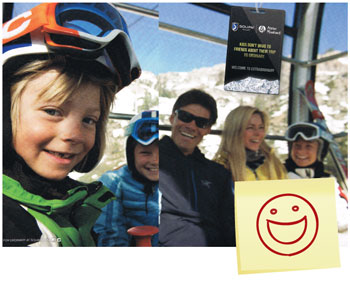 This one’s different. It has a bit of mystery. It's not exactly the Mona Lisa, but it makes me wonder: what did she just say? Apparently, it was pretty funny, because everyone else is laughing. Maybe she bragged that she’s better than me. The out-of-focus craggy peaks in the background lend weight to the ad line, “Kids don’t brag to friends about their trip to ordinary.” And whispered in the lower left corner is the call to action: “find the cure for ordinary at Squaw.com.”—R.K.
This one’s different. It has a bit of mystery. It's not exactly the Mona Lisa, but it makes me wonder: what did she just say? Apparently, it was pretty funny, because everyone else is laughing. Maybe she bragged that she’s better than me. The out-of-focus craggy peaks in the background lend weight to the ad line, “Kids don’t brag to friends about their trip to ordinary.” And whispered in the lower left corner is the call to action: “find the cure for ordinary at Squaw.com.”—R.K.
BEST IMAGE-BUSTING: JACKSON HOLE, WYO.
Jackson Hole has been trying to broaden its image beyond powder and steeps and to win the hearts of aspiring intermediates.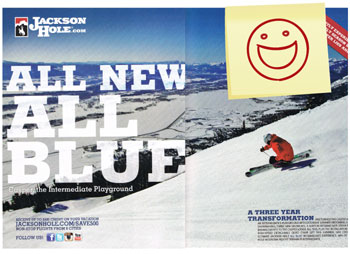 This ad shows Jackson Hole in all its sprawling, inspiring glory, but the pitch makes this giant mountain appear accessible to just about everyone adventurous enough to dream of tackling the wilds of Wyoming in the first place. That’s a message guaranteed to get the blood racing in every eager intermediate. To quibble, the verbal message almost overwhelms the visual proof. —R.K.
This ad shows Jackson Hole in all its sprawling, inspiring glory, but the pitch makes this giant mountain appear accessible to just about everyone adventurous enough to dream of tackling the wilds of Wyoming in the first place. That’s a message guaranteed to get the blood racing in every eager intermediate. To quibble, the verbal message almost overwhelms the visual proof. —R.K.
BEST PERSONAL APPEAL: JAY PEAK, VT.
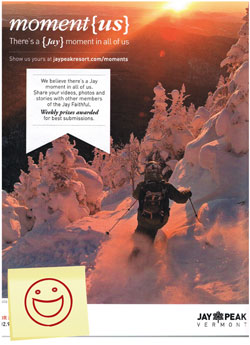 Many areas seek to marry print and online involvement; the “moment{us}” campaign nails it. First, it’s a striking photo; red is rarely the predominant color in a sport of white snow and blue skies. Second, the photo embodies the tag line, “There’s a Jay moment in all of us,” as it was submitted by a regular skier. Third, the ad invites readers to submit their own photos, to show and tell about their “moments,” and to check out the readers’ photo album. And fourth, contributors’ comments on their “moments,” posted online, are completely awesome. Short, quick stories and memories from the mountain—real Jay Peak experiences, hundreds of them. This is as authentic as advertising gets. —R.K.
Many areas seek to marry print and online involvement; the “moment{us}” campaign nails it. First, it’s a striking photo; red is rarely the predominant color in a sport of white snow and blue skies. Second, the photo embodies the tag line, “There’s a Jay moment in all of us,” as it was submitted by a regular skier. Third, the ad invites readers to submit their own photos, to show and tell about their “moments,” and to check out the readers’ photo album. And fourth, contributors’ comments on their “moments,” posted online, are completely awesome. Short, quick stories and memories from the mountain—real Jay Peak experiences, hundreds of them. This is as authentic as advertising gets. —R.K.
BIGGEST UNDERSTATEMENT: STOWE, VT.
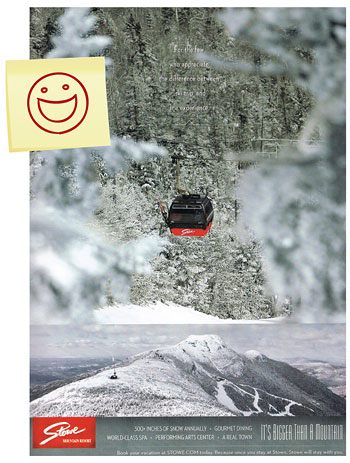 The ski capital of the East bucked convention, muting its colors and whispering, “For the few who appreciate the difference between ski trip and life experience.” Fair enough: Mt. Mansfield towers over the rest of Vermont and puts Stowe in a different league. And that’s what the photo shows: the resort is stuffed with snow, and Mansfield dwarfs the landscape around it. By daring to speak softly, Stowe breaks through the clutter and gets attention. —R.K.
The ski capital of the East bucked convention, muting its colors and whispering, “For the few who appreciate the difference between ski trip and life experience.” Fair enough: Mt. Mansfield towers over the rest of Vermont and puts Stowe in a different league. And that’s what the photo shows: the resort is stuffed with snow, and Mansfield dwarfs the landscape around it. By daring to speak softly, Stowe breaks through the clutter and gets attention. —R.K.
BEST WAY TO SCARE YOUR CUSTOMERS: TAOS, N.M.
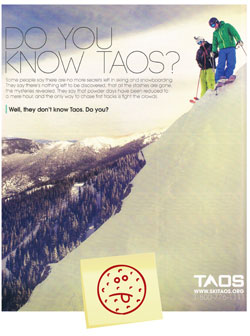 Taos’s ad, with the title, “Do you know Taos?” managed to scare even me. The picture of two guys perched at the top of some gnarly steeps with rocks sticking out will not make the average person want to know much more about Taos. The litany of lies leading to “Well, they don’t know Taos. Do you?” doesn’t really help explain why I should want to know, either. Also: at a quick glance, it looks like “they” refers to the two guys. Were they being punk’d by Taos? —R.K.
Taos’s ad, with the title, “Do you know Taos?” managed to scare even me. The picture of two guys perched at the top of some gnarly steeps with rocks sticking out will not make the average person want to know much more about Taos. The litany of lies leading to “Well, they don’t know Taos. Do you?” doesn’t really help explain why I should want to know, either. Also: at a quick glance, it looks like “they” refers to the two guys. Were they being punk’d by Taos? —R.K.
MOST ENIGMATIC (SKIING): STRATTON MOUNTAIN, VT.
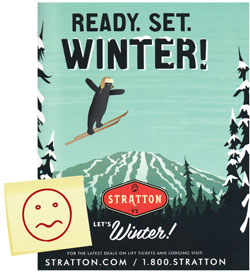 This illustrated pitch baffles me. It’s been awhile (okay, 33 years) since I was a regular at Stratton, so I’m not as clued in as I once was. And I’m still in the dark. This ad tells me nothing about the current state of skiing, riding, and nightlife at Stratton, although it’s clear that the mountain profile remains the same, and the bear is still the resort’s symbol. But why is the bear on jumping skis? Why should I go to Stratton rather than, say, Okemo or Killington? I just don’t see who this is aimed at. Is it in code? —R.K.
This illustrated pitch baffles me. It’s been awhile (okay, 33 years) since I was a regular at Stratton, so I’m not as clued in as I once was. And I’m still in the dark. This ad tells me nothing about the current state of skiing, riding, and nightlife at Stratton, although it’s clear that the mountain profile remains the same, and the bear is still the resort’s symbol. But why is the bear on jumping skis? Why should I go to Stratton rather than, say, Okemo or Killington? I just don’t see who this is aimed at. Is it in code? —R.K.
WORST USE OF PHOTOGRAPHY: BRETTON WOODS, N.H.
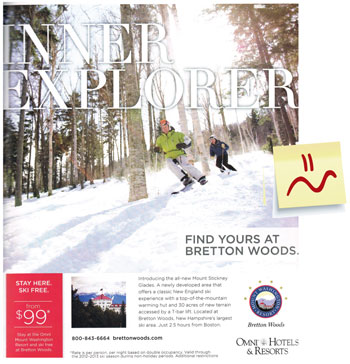 Bretton Woods, in an attempt to tout its new glades, featured a washed-out shot of two men skiing in trees. Besides being washed out, the photo lacked any pop or excitement with the subjects. The guy in front is smiling, but the guy behind isn't. There isn’t even enough snow to have to pull your goggles down...or to cover up the boots and skis. Further, the tagline, “Inner Explorer,” is in white against a washed-out background. Very little exploration happening here.—R.K.
Bretton Woods, in an attempt to tout its new glades, featured a washed-out shot of two men skiing in trees. Besides being washed out, the photo lacked any pop or excitement with the subjects. The guy in front is smiling, but the guy behind isn't. There isn’t even enough snow to have to pull your goggles down...or to cover up the boots and skis. Further, the tagline, “Inner Explorer,” is in white against a washed-out background. Very little exploration happening here.—R.K.
CLOSE BUT NO CIGAR (AGAIN): CRESTED BUTTE
We liked CB’s “Butteness”concept a year ago, but the execution came up short. Using local athletes this year to explain Butteness (without calling it that) was an an effective personal touch. If they choose to live and ski here, it must be a cool place. But there’s not enough story here to explain what’s so cool.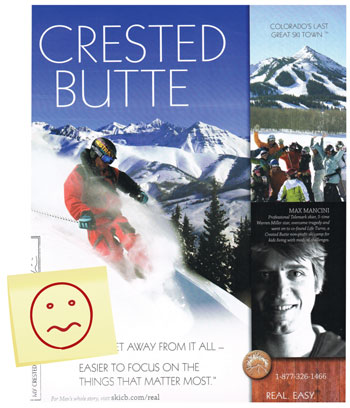 We’re urged to see the “whole story” online, but there’s no more story about Crested Butte there—it’s all about the individual, and much of it is divorced from why they are in Crested Butte. And that’s what we want to know. If I go there, where might I rub elbows with Wayne Wong? Or Wendy Fisher? I want to ski where they ski, hang where they hang, and thus get the insider’s tour of CB. —R.K.
We’re urged to see the “whole story” online, but there’s no more story about Crested Butte there—it’s all about the individual, and much of it is divorced from why they are in Crested Butte. And that’s what we want to know. If I go there, where might I rub elbows with Wayne Wong? Or Wendy Fisher? I want to ski where they ski, hang where they hang, and thus get the insider’s tour of CB. —R.K.
MOST THOUGHT-PROVOKING: SCARPA
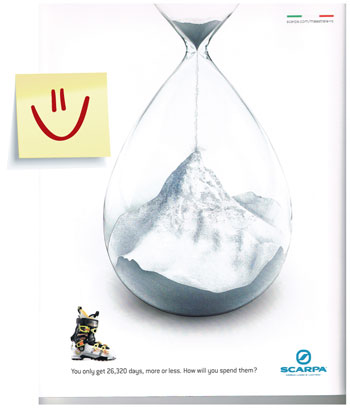 Scarpa subtly urges adventurers to go off-piste with its backcountry ski boots via a clever, terse message. As sand slips through the hourglass, forming an alluring white peak in the bottom bulb, the copy says, “You only get 26,320 days, more or less. How will you spend them?” That’s a sobering thought; when you look at life that way, there’s no time to waste. This didn’t send me to the nearest store to shell out $750 or more for a pair of backcountry boots—I don’t hike for my turns that often—but it inspired me to get in an extra three or four days this season. —R.K.
Scarpa subtly urges adventurers to go off-piste with its backcountry ski boots via a clever, terse message. As sand slips through the hourglass, forming an alluring white peak in the bottom bulb, the copy says, “You only get 26,320 days, more or less. How will you spend them?” That’s a sobering thought; when you look at life that way, there’s no time to waste. This didn’t send me to the nearest store to shell out $750 or more for a pair of backcountry boots—I don’t hike for my turns that often—but it inspired me to get in an extra three or four days this season. —R.K.
BEST PACKAGE SELL: WHISTLER/BLACKCOMB, B.C.
Time was, print was for image ads. More and more, though, resorts are selling both the sizzle and the steak, showcasing spectacular skiing and vistas and hawking inexpensive packages to access all that goodness. It takes careful balance to keep either of these efforts from overwhelming the other. 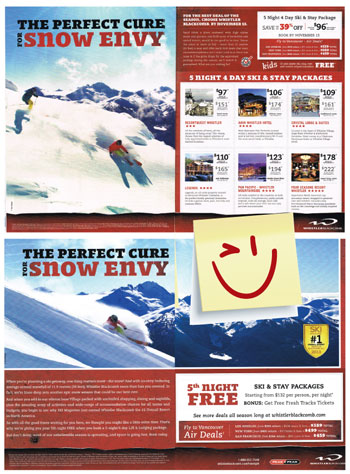 Whistler strikes the right balance, from its “Be Here” for the World Ski & Snowboard festival to its “Snow Envy” creative. In all these, Whistler clearly shows folks why they want to come, and then tells them how affordable it can be. —R.K.
Whistler strikes the right balance, from its “Be Here” for the World Ski & Snowboard festival to its “Snow Envy” creative. In all these, Whistler clearly shows folks why they want to come, and then tells them how affordable it can be. —R.K.
BEST FAMILY APPEAL: SMUGGLERS’ NOTCH, VT.
If you’re already known as a family resort, how do you stand out from all the cute-kid ads? Smuggs’ collage showcases fun for everyone in the family. It’s not easy to create a collage that grabs attention; too often, such efforts just look busy. This one works, in part because of the variety portrayed in the thumbnails. 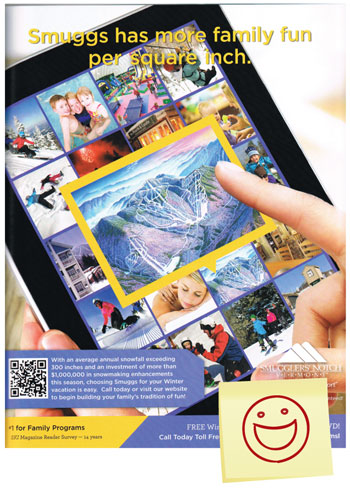 Putting the collage on an iPad is a nice touch; the overall impact is more engaging than a plain collection of photos. And it subtly suggests readers go pick up their iPad and connect with the resort. —R.K.
Putting the collage on an iPad is a nice touch; the overall impact is more engaging than a plain collection of photos. And it subtly suggests readers go pick up their iPad and connect with the resort. —R.K.
SNOWBOARDING
MOST OPPORTUNISTIC USE OF CATS: BIG BOULDER PARK, PA.
This ad taps my affection for cat memes. Tucked away in the back of Transworld, it caught my eye immediately, not just for the cats but for the fact that it didn’t look like anything else in the mag.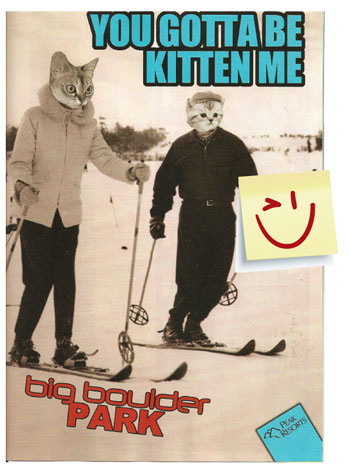 Featuring two retro skiers with cat heads Photoshopped onto human bodies, the only copy on the page reads “YOU GOTTA BE KITTEN ME.” (Hilarious.) Not completely abandoning reason for ridiculousness, the facing page shows a map of Peak Resort locations and copywriting extolling its proximity to “you,” the presumably East Coast rider. Stark, easy to read, funny and unlike anything else around it.
Featuring two retro skiers with cat heads Photoshopped onto human bodies, the only copy on the page reads “YOU GOTTA BE KITTEN ME.” (Hilarious.) Not completely abandoning reason for ridiculousness, the facing page shows a map of Peak Resort locations and copywriting extolling its proximity to “you,” the presumably East Coast rider. Stark, easy to read, funny and unlike anything else around it.
A related campaign inFreeskier omitted the kittens. But the map of the “Mid West Coast,” and copy touting snowmaking, awesome parks, and sufficient elevation to stay above rising sea levels, were equally eye-catching.—K.B.
BEST ILLUSTRATED CREATIVE: BEAR MOUNTAIN, CALIF.
The resort has a long track record of killing it in the ad-creative department and this year managed to stand out once again. I find my eye is often attracted to illustrated ads in snowboard mags, simply because they stand out amongst all of the incredible photos. But Bear just has such as solid grasp of their target demo and they cater to it relentlessly. The copywriting is pithy and on-point, using lingo without overdoing it, and I like the idea of the terrain park as “feature factory,” a fantasy that is expertly illustrated alongside. A great example of an ad perfectly tailored to its audience and medium. Nice job as always, Bear.—K.B.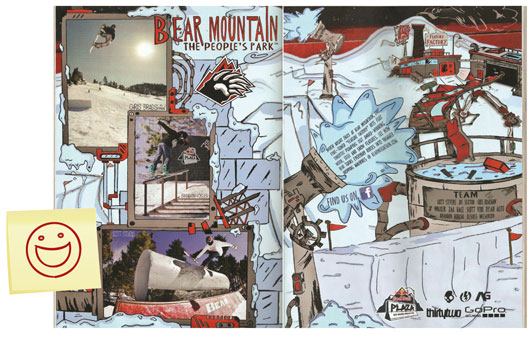
MOST ENIGMATIC (SNOWBOARDING): OWL’S HEAD, QUEBEC
I’m always hesitant to call out smaller resorts for less-than-award-worthy ads, but the photo in this ad was just too weird not to note. Located in Quebec’s famous Eastern Townships region, Owl’s Head is a little destination resort with a cute logo and low-key marketing. So instead of riding out the owl theme or the beautiful scenery, this ad featured a giant, close-cropped, almost-full-page photo of a dude drinking from a Camelbak.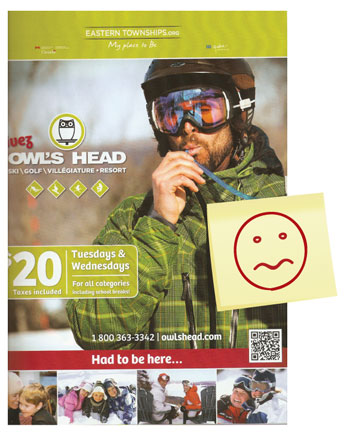 The tagline is “Had to be there.” For what? Rehydration? Or is that booze and something hangover-esque that happened afterward? Very strange, Owl’s Head, very strange.—K.B.
The tagline is “Had to be there.” For what? Rehydration? Or is that booze and something hangover-esque that happened afterward? Very strange, Owl’s Head, very strange.—K.B.
BEST/WORST USE OF NIGHTLIFE: KILLINGTON/ASPEN
Killington and Aspen Snowmass both decided to play up nightlife rather than snowboarding or terrain parks. And that’s okay: I hear snowboarders sometimes like to party. [Ed. note: the ads also ran in the ski books, since some skiers like to party, too.] Both ads featured blurry bar shots.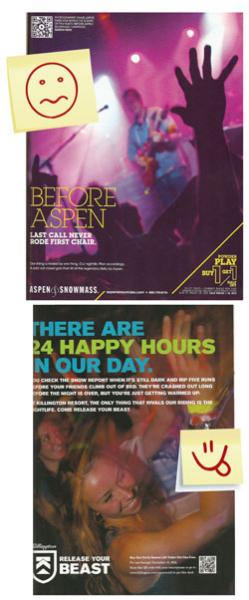 Both ads featured a slight variation of the phrase “the only thing that rivals our riding is our nightlife.” So this becomes a battle of the taglines. Killington: “There are 24 happy hours in our day.” Aspen: “Before Aspen, last call never rode first chair.” Both are pretty clever on the “we’re talking about getting wasted without talking about getting wasted” angle. I prefer Killington’s, because having 24 happy hours in a day sounds awesome. Having the words “last call” and “first chair” too close together scares me. —K.B.
Both ads featured a slight variation of the phrase “the only thing that rivals our riding is our nightlife.” So this becomes a battle of the taglines. Killington: “There are 24 happy hours in our day.” Aspen: “Before Aspen, last call never rode first chair.” Both are pretty clever on the “we’re talking about getting wasted without talking about getting wasted” angle. I prefer Killington’s, because having 24 happy hours in a day sounds awesome. Having the words “last call” and “first chair” too close together scares me. —K.B.
BEST WAY TO DO THE DEW: BRECKENRIDGE, COLO.
Nailed it! I loved this ad, and the concept/campaign it’s promoting. Breck capitalized on its investment in hosting a Winter Dew Tour stop with a contest to let fans design a terrain park feature for the event.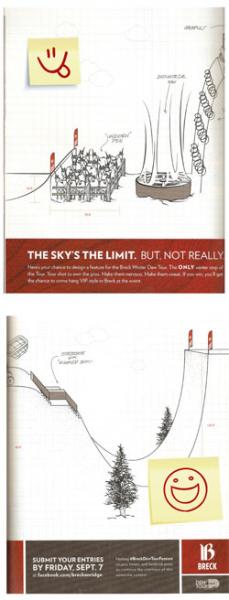 This DPS pokes fun of both itself and the crazy-bigness of some park features with a mock-up of a fantasy feature: mega-ramp to catapult, over industrial-sized fan (you know, for amplitude), a pen full of unicorns (for extra-consequence) and a ramp landing. The tagline: “The sky’s the limit. But not really.” Simple, well executed, full of all the pertinent information, this ad was compelling, effective and perfect for its target audience (snowboarding and art go together like peas and carrots). —K.B.
This DPS pokes fun of both itself and the crazy-bigness of some park features with a mock-up of a fantasy feature: mega-ramp to catapult, over industrial-sized fan (you know, for amplitude), a pen full of unicorns (for extra-consequence) and a ramp landing. The tagline: “The sky’s the limit. But not really.” Simple, well executed, full of all the pertinent information, this ad was compelling, effective and perfect for its target audience (snowboarding and art go together like peas and carrots). —K.B.
BIGGEST MISSED OPPORTUNITY: MIKE WIEGELE HELICOPTER SKIING, B.C.
As a good Canadian who pours a high percentage of her disposable income into domestic winter travel, Mike Wiegele’s is on My List. So, when you’re the keeper of the most treasured of winter dreams, why make an ad that looks like it belongs in a service-industry trade magazine?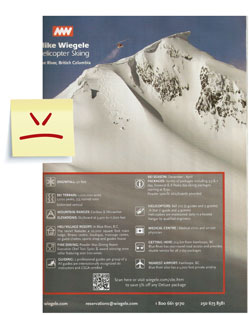 Wiegele filled half of this full-page glossy with an icon-tagged list of statistics usually relegated to the last page of a tri-fold brochure. Worse, the ad appeared in the Backcountry section of the SBC Resort Guide, which consists of listings-style editorial. So right beside the ad is a chunk of editorial listing many of the same stats. A missed opportunity. —K.B.
Wiegele filled half of this full-page glossy with an icon-tagged list of statistics usually relegated to the last page of a tri-fold brochure. Worse, the ad appeared in the Backcountry section of the SBC Resort Guide, which consists of listings-style editorial. So right beside the ad is a chunk of editorial listing many of the same stats. A missed opportunity. —K.B.
CONTRIBUTORS:
• Samantha Rufo is president of nxtConcepts, an Interactive Marketing & Media Company.
• Milena Regos is the owner of Out&About Marketing, a digital and social media consultancy at Lake Tahoe. www.outandaboutmarketing.com,
milena@outandaboutmarketing.com.
• Gregg Blanchard is the founder of Slopefillers.com, where he blogs about digital media and resort marketing efforts, and is
director of communications for Ryan Solutions.
• Canadian Katie Bailey is a snowboarder, writer, and longtime SAM contributing editor.




